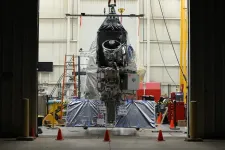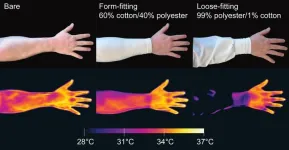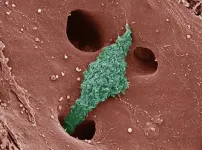(Press-News.org) Scientists and engineers are ready to fly an infrared mission called EXCITE (EXoplanet Climate Infrared TElescope) to the edge of space.
EXCITE is designed to study atmospheres around exoplanets, or worlds beyond our solar system, during circumpolar long-duration scientific balloon flights. But first, it must complete a test flight during NASA’s fall 2024 scientific ballooning campaign from Fort Sumner, New Mexico.
“EXCITE can give us a three-dimensional picture of a planet’s atmosphere and temperature by collecting data the whole time the world orbits its star,” said Peter Nagler, the mission’s principal investigator at NASA’s Goddard Space Flight Center in Greenbelt, Maryland. “Only a handful of these types of measurements have been done before. They require a very stable telescope in a position to track a planet for several days at a time.”
EXCITE will study hot Jupiters, giant gas exoplanets that complete an orbit once every one to two days and have temperatures in the thousands of degrees. The worlds are tidally locked, which means the same side always faces the star.
The telescope will observe how heat is distributed across the planet, from the scalding hemisphere facing the star to the relatively cooler nightside.
It will also determine how molecules in a world’s atmosphere absorb and emit light over the entire orbit, a process called phase-resolved spectroscopy. Not only can this data reveal the presence of compounds — like water, methane, carbon dioxide, and others — but also how they circulate globally as the planet orbits its star.
NASA’s Hubble, James Webb, and retired Spitzer space telescopes have collected a handful of these measurements between them.
In 2014, for example, Hubble and Spitzer observed an exoplanet called WASP-43 b. To collect data over the world’s 22-hour day, scientists needed 60 hours of Hubble time and 46 hours from Spitzer. Resource-intensive studies like this on space-based observatories are difficult. Time is a limited resource, and studies must compete with hundreds of other requests for that time.
“During its first science flight, EXCITE aims to fly for over a dozen days from the Columbia Scientific Balloon Facility’s site in Antarctica,” said Kyle Helson, an EXCITE team member and a research scientist at the University of Maryland, Baltimore County and NASA Goddard. “And at the pole, the stars we’ll study don’t set, so our observations won’t be interrupted. We hope that the mission will effectively double the number of phase-resolved spectra available to the science community.”
EXCITE will fly to about 132,000 feet (40 kilometers) via a scientific balloon filled with helium. That takes it above 99.5% of Earth’s atmosphere. At that altitude, the telescope will be able to observe multiple infrared wavelengths with little interference.
“The telescope collects the infrared light and beams it into the spectrometer, where it kind of goes through a little obstacle course,” said Lee Bernard, an EXCITE team member and a graduate research assistant at Arizona State University in Tempe. “It bounces off mirrors and through a prism before reaching the detector. Everything must be aligned very precisely — just a few millimeters off center and the light won’t make it.”
The spectrometer rests inside a vessel called a cryostat situated behind the telescope. The cryostat cools the spectrometer’s detector — once a flight candidate from Webb'sNIRSpec (Near InfraRed Spectrograph)— to about 350 degrees below zero Fahrenheit (minus 210 degrees Celsius) so it can measure tiny intensity changes in the infrared light.
The entire telescope and cryostat assembly rests in a rowboat-shaped base where it can rotate along three axes to maintain stable pointing down to 50 milliarcseconds. That’s like holding a steady gaze on a U.S. quarter coin from 65 miles away.
“Several different institutions contributed to EXCITE’s subsystems,” said Tim Rehm, an EXCITE team member and a graduate research assistant at Brown University in Providence, Rhode Island. “It’s great to see them all assembled and working together. We’re excited to do this test flight, and we’re looking forward to all the future science flights we hope to have.”
The EXCITE instrument was primarily built by NASA Goddard, Brown, Arizona State University, and StarSpec Technologies in Ontario, with additional support from collaborators in the U.S., Canada, Italy, and the United Kingdom.
NASA’s scientific balloons offer frequent, low-cost access to near-space to conduct scientific investigations and technology maturation in fields such as astrophysics, heliophysics, and atmospheric research, as well as training for the next generation of leaders in engineering and science. To follow the missions in the 2024 Fort Sumner fall campaign, visit NASA’s CSBF (Columbia Scientific Balloon Facility) website for real-time updates of a balloon’s altitude and GPS location during flight.
NASA’s Wallops Flight Facility in Virginia manages the agency’s scientific balloon flight program with 10 to 15 flights each year from launch sites worldwide. Peraton, which operates CSBF in Texas, provides mission planning, engineering services, and field operations for NASA’s scientific balloon program. The CSBF team has launched more than 1,700 scientific balloons over some 40 years of operations. NASA’s balloons are fabricated by Aerostar. The NASA Scientific Balloon Program is funded by the NASA Headquarters Science Mission Directorate Astrophysics Division.
END
NASA’s EXCITE mission prepared for scientific balloon flight
2024-08-23
ELSE PRESS RELEASES FROM THIS DATE:
New gels could protect buildings during wildfires
2024-08-23
As climate change creates hotter, drier conditions, we are seeing longer fire seasons with larger, more frequent wildfires. In recent years, catastrophic wildfires have destroyed homes and infrastructure, caused devastating losses in lives and livelihoods of people living in affected areas, and damaged wildland resources and the economy. We need new solutions to fight wildfires and protect areas from damage.
Researchers at Stanford have developed a water-enhancing gel that could be sprayed on homes and critical infrastructure to help keep them from burning during wildfires. The research, published Aug. ...
U.S. National Science Foundation awards UT $18 million to study factors that lead to pandemics
2024-08-22
Professor of Ecology and Evolutionary Biology Nina Fefferman became a mathematician because she loves puzzles. She’s just been awarded $18 million from the U.S. National Science Foundation to solve one puzzle that has the potential to change the world: how, when and why an infection in a population will spread, or cause an epidemic or pandemic, rather than dying out.
Fefferman, director of the National Institute for Modeling Biological Systems and associate director of the UT One Health Initiative at the University ...
Mosquitoes sense infrared from body heat to help track humans down
2024-08-22
(Santa Barbara, Calif.) — While a mosquito bite is often no more than a temporary bother, in many parts of the world it can be scary. One mosquito species, Aedes aegypti, spreads the viruses that cause over 100,000,000 cases of dengue, yellow fever, Zika and other diseases every year. Another, Anopheles gambiae, spreads the parasite that causes malaria. The World Health Organization estimates that malaria alone causes more than 400,000 deaths every year. Indeed, their capacity to transmit disease has earned mosquitoes the title of deadliest ...
DOD grants CU researchers $5 Million to study antibiotic-resistant wound infections in Ukraine
2024-08-22
Faculty members in the Department of Emergency Medicine at the University of Colorado School of Medicine have been awarded $5 million by the U.S. Department of Defense to work with partners in Ukraine on clinical and logistical challenges associated with modern large-scale combat operations and prolonged casualty care.
The overarching program — Research and Scalable Infrastructure to Improve Outcomes on the Front Lines of Ukraine by Advancing Treatment and Evaluation (RESOLUTE) — is focusing on collecting data related to antibiotic-resistant wound infections, which have substantially increased amid the military conflict.
The initial project — ...
3D body volume scanner uses AI to help predict metabolic syndrome risk
2024-08-22
ROCHESTER, Minn. — Mayo Clinic researchers are using artificial intelligence (AI) with an advanced 3D body-volume scanner – originally developed for the clothing industry – to help doctors predict metabolic syndrome risk and severity. The combination of tools offers doctors a more precise alternative to other measures of disease risk like body mass index (BMI) and waist-to-hip ratio, according to findings published in the European Heart Journal - Digital Health.
Metabolic syndrome can lead to heart attack, stroke and other serious health issues and affects over a third of the U.S. population and a quarter of people globally. ...
Building a COMPASS to navigate future pandemics
2024-08-22
Viruses like SARS-CoV-2 don’t respect boundaries, moving between species and continents and leaving destruction as they go. Beating the next pathogen with pandemic potential means getting good at crossing borders ourselves — between fields of study, between research universities, and between scientists and the wider community.
An $18 million grant announced by the U.S. National Science Foundation (NSF) will put that goal within reach. The award brings together five universities and more than 20 researchers, academics, and public health experts to establish the Virginia Tech-led Center ...
Macrophage mix helps determine rate and fate of fatty liver disease
2024-08-22
Formerly known as nonalcoholic steatohepatitis, metabolic dysfunction-associated steatohepatitis (MASH) is an inflammatory disease characterized by liver scarring or fibrosis that progressively impairs liver function.
It is a major risk factor for cirrhosis and liver cancer. And because treatment options are limited, MASH is the second leading cause for liver transplants in the United States after cirrhosis caused by chronic hepatitis C infection.
A better understanding of the pathological processes that drive MASH is critical to creating effective treatments. In a new paper published ...
Department of Energy announces $36 million to support energy-relevant research in underrepresented regions of America
2024-08-22
WASHINGTON, D.C. - Ensuring that scientific funding goes to states and territories that have typically received smaller fractions of federal research dollars in the past, the Department of Energy (DOE) today announced $36 million in funding for 39 research projects in 19 states via the Established Program to Stimulate Competitive Research (EPSCoR). The grants connect innovative ideas from scientists at eligible institutions with leading-edge capabilities at the DOE national laboratories.
Supporting scientists while building the expertise and capabilities critical for performing leading research ...
Analysis of 1,500 climate policies reveals only a small fraction achieved significant emission reductions
2024-08-22
A new machine learning analysis has revealed the most effective climate policies out of 1,500 implemented worldwide over the last two decades. Some of the success stories – numbered at about 63 – involve rarely studied policies and unappreciated policy combinations. “Our results provide a clear yet sobering perspective on the policy effort necessary for closing the remaining emissions gap of 23 billion tons carbon dioxide (CO2) by 2023,” write the authors. To achieve the Paris Agreement’s climate targets, it is essential to know which ...
Fatty-acid derived polymers yield recyclable and highly versatile adhesives
2024-08-22
Researchers have presented a new family of polymer adhesives that offer a sustainable and recyclable alternative to conventional polymer adhesives and can be used across a wide range of applications, from industrial adhesives to surgical superglues. The new chemical approach to aLA polymerization addresses the performance and environmental challenges of traditional polymers, providing environmentally friendly adhesive solutions. Polymer adhesives are ubiquitous in modern life and are widely used in many medical, consumer, and industrial products. Given this diversity, each adhesive material is often tailored ...





